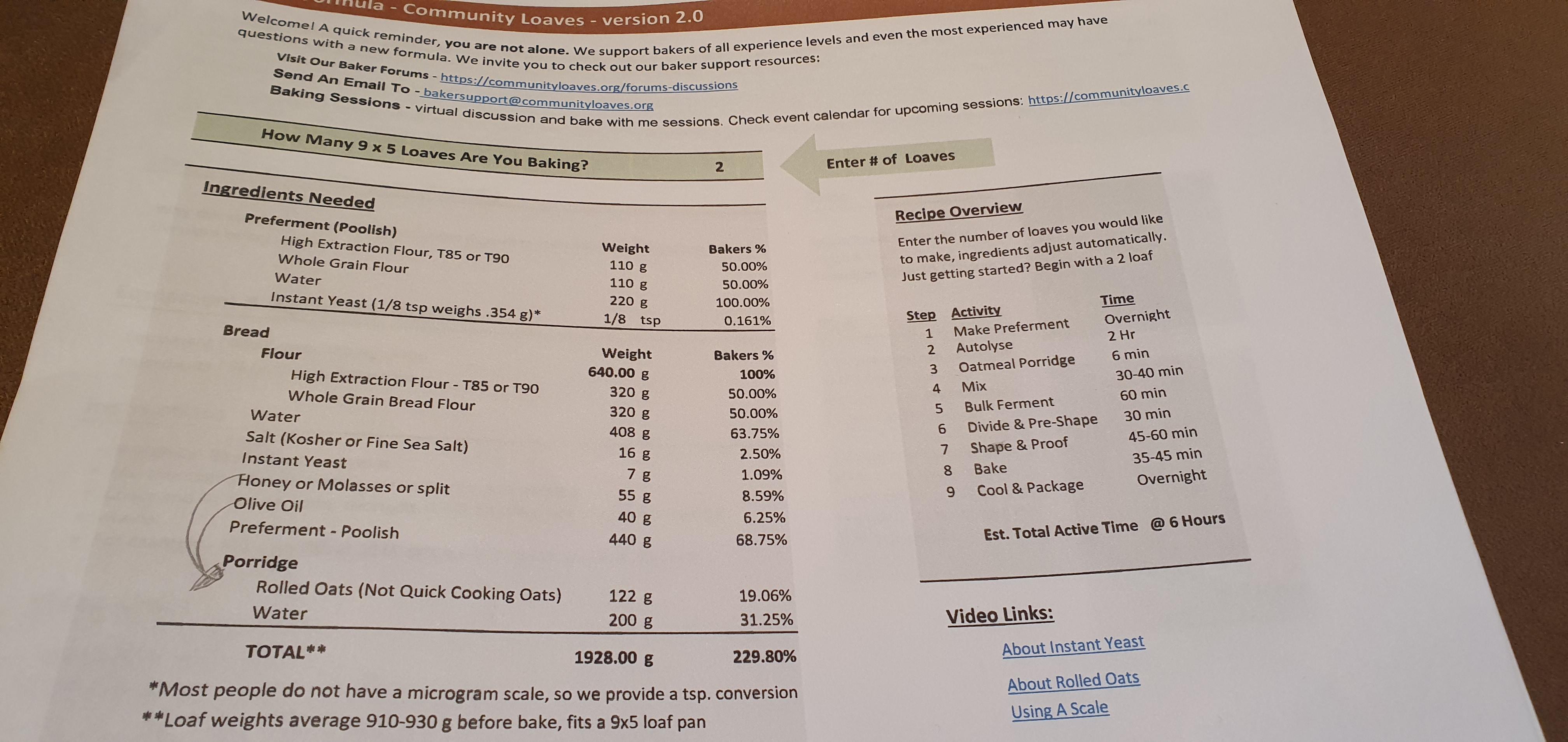Home › Forums › Baker Forums › Our Formulas › The Modern › NEW MODERN FORMULA – SEPTEMBER 15TH
Tagged: #Modern Formula, #Yeast Recipe
- This topic has 125 replies, 35 voices, and was last updated 1 year, 1 month ago by Joanna Olmstead.
-
AuthorPosts
-
November 6, 2021 at 8:33 am #6547Sarah StineParticipant
Katherine, yes I will be there. Thanks for your help. I’m attaching a photo of the formula I am working from. Perhaps the two loaf calculations are scaling up to three? See you on Tuesday.
 November 6, 2021 at 7:05 am #6545Katherine KehrliKeymaster
November 6, 2021 at 7:05 am #6545Katherine KehrliKeymasterGabrielle and Sarah,
Can you join me on the baker debrief this week? It is Tuesday, 11:30 – 12:30, the zoom link is on the event calendar. I’m confident the formula works and scales. Just did a 10 loaf batch yesterday. The bulging and cracking is a sign of under proofing. You may be having challenges with your mixing. The Modern is the most reliable of all our formulas so I’m confident we can figure this out.
A zoom call on Tuesday will help. You can also come “bake with me” on Friday November 12th. This is a limited hands on session for 6 people. Link for that is also on the event calendar.
We will get this dialed in!
Katherine
November 5, 2021 at 10:22 am #6511Gabrielle HerringParticipantSarah Stone and Katherine, this might be why I’m having so much trouble with the new modern formula. The bread cracks on one side and then bulges out as if there is too much dough in the pan. But when I divided the total grams in the recipe by 3 there wouldn’t be enough dough for three loaves. I’ve tried everything shorter timing on every step. I have 2 USA 10*5 loaf pans I will experiment on my next bake. Any tips from others if they are having the same issue?
November 4, 2021 at 6:46 pm #6498Katherine KehrliKeymasterSarah,
That is bizarre?
I just downloaded the recipe and scaled for 10, no issues, shouldn’t have any challenges with 3 I’m checking right now…. my download, about an hour ago is right on 2800 g for 3 loaves. I wonder what might have happened. We have been making fixes but not to the “original”.
I’m glad you caught it on your mix, and that you are making 3 loaves. Great! Sorry for the confusion. It does seem to be working. Please keep me posted.
Katherine
November 4, 2021 at 6:37 pm #6496Sarah StineParticipantHi, I’m a new member of the Community Loaves family and this was my first bake. Using the spreadsheet for 2 loaves Modern Formula I found an error. When you enter 2 loaves it actually gives you the Ingredients for 3. After going through all the steps I figured this out when dividing into 940g loaves. It was enough for 3 plus a little.
October 10, 2021 at 12:24 pm #5731Katherine KehrliKeymasterTina,
I have to say that although I prefer the spritz, sprinkle and press method myself I do believe the rolling on the damp towel and then in a tray of oats creates a more polished loaf appearance. Thanks for reminding of this method. It is slightly more involved but it does indeed create a beautiful loaf!
Katherine
October 9, 2021 at 5:40 pm #5711Katherine KehrliKeymasterTrina,
Did you want the KitchenAid – Be Kind to Your Mixer video? You’ll find it under Baker Resources, Breaducation. That video is worth watching for the 4 and the 6 version for managing the mix.
Katherine
October 9, 2021 at 5:40 pm #5710Katherine KehrliKeymasterTrina,
Did you want the KitchenAid – Be Kind to Your Mixer video? You’ll find it under Baker Resources, Breaducation. That video is worth watching for the 4 and the 6 version for managing the mix.
Katherine
October 9, 2021 at 5:38 pm #5709Tina EllisParticipantI find rolling the loaves on a really wet kitchen towel, then rolling in the oats has been the best way for me to keep the oats from falling off. But, my dogs are super happy with this option. They love the toasted oats that fall off.
October 9, 2021 at 5:38 pm #5708Katherine KehrliKeymasterSpot –
All videos can also be found on the Breaducation page under Baker Resources. That is our master library!
Katherine
October 9, 2021 at 5:35 pm #5703Tina EllisParticipantI watched the mixer video before I started. I wanted to see how my mixer did with the 4 loaves with this new formula. My mixer could handle the older formula. I was curious to see how it would do with this much dough. It’s literally a handful too much dough. If I removed about a fist size ball, my mixer had no problems. I was curious if I could find a workaround and still do a 4-loaf batch. I will probably switch to doing a 6-loaf batch, but I need to buy 2 more pans first. I only have 4.
Thanks for the tips on the new formula. I especially like waiting to add the oatmeal until after the dough passes the windowpane test. I never had luck pulling a good windowpane when the oatmeals was mixed in, so a lot of my earlier loaves were by feel and look – and a lot of crossed fingers.
October 6, 2021 at 5:21 pm #5651Katherine KehrliKeymasterTerry,
Did you have a chance to watch this video – be kind to your KitchenAid? If you have a smaller 5 quart KitchenAid, mix two loaves at a time, but scale everything for four. The video will help. Even with a 6 quart KitchenAid – create a batch of 4-6 but mix as 3.
Katherine
October 6, 2021 at 3:25 pm #5645Terry JonesParticipantToday was my first try at the new formula. It was a struggle for my mixer. With the previous formula, I mixed everything by hand, then split the dough into two parts for the kneading process. It worked remarkably well. This one not so much. Anticipating the problem, I cut the recipe into 3 loaves, but my mixer overheated as it tried to tackle all that dough as I mixed the autolyse into the levain. I think my mixer will only accommodate 2 loaves at a time. Is there a way to bake 4 loaves by splitting up the dough into two parts? If so, at what point do you do that? What if I hand mixed the autolysed flour, levain, yeast and salt by hand, then split the dough in half to knead by machine? I could then add the oatmeal half at a time into the dough. However, by the time I do all that, I really am right back to the previous recipe…Advice?
October 4, 2021 at 4:39 pm #5591Katherine KehrliKeymasterThis is a great question. Technically longer is worse for autolyse. After about 2 hours of autolysing the flour starts to break down, you get starch degradation. This is straight from cereal scientist Ross Andrews Oregon State University. So we don’t recommend the longer autolyse, but if time gets the better of you don’t through away the autolyse, use it.
October 4, 2021 at 4:33 pm #5590Gabrielle HerringParticipantJust asking also curious would it be possible to do the autolyse the night before? So it might have a possible 8-10 hours of hydrating?
-
AuthorPosts
- You must be logged in to reply to this topic.


